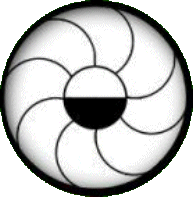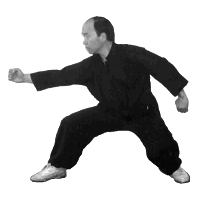This article appeared in the November, 1981, issue of Inside Kung Fu magazine.
BA SHI - The Eight Basic Stances:
The Foundation of Kung Fu
By Richard Miller
Kung fu (hard work and dedication to a skill over a long period of time), wu shu (martial art), guo shu (Chinese martial art), and ji ji (fighting technique) are all terms frequently used to mean Chinese martial arts. Two terms not so often heard are bai da (bare hand fighting) and chuan yong (possession of brave spirit and martial technique). In Northern China an additional term, ba shi, is used. Aside from ba shi's broad meaning, signifying martial art, is a more specialized reference: The Eight Basic Stances.
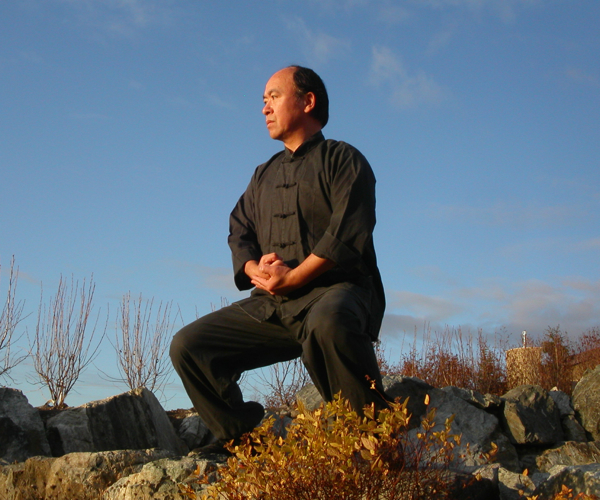
It is said that 70% of Northern Chinese kung fu is “leg,” and that 30% is “hand.” It is commonly thought that the 70% refers to kicking. This is a misconception. In fact, the 70% refers to what the Chinese call bu, meaning step or footwork. The ba shi is a fundamental tool in training the legs for powerful, decisive footwork. Practicing the ba shi, however, builds not only physical strength, it cultivates qi, and the instrument of mental strength: a calm, patient mind.
Sifu Adam Hsu has researched the ba shi. During the more than 20 years of his own martial arts study, he has seen the ba shi taught in many different styles and by many different sifus. He has noticed that only the first six of the eight stances are standard: qi ma shi (horse-riding stance), gong jian shi (bowand-arrow stance), xi shi (empty-leg stance), pu tui shi (low leg-stretching stance), du li shi (single-leg stance), zuo pan shi (seated-on-own-twisted-leg stance). Note: Shi means stance. Bu is sometimes used interchangeably with shi. This is incorrect. As stated before, bu means step.
The remaining two stances vary. These two often are characteristic of the particular style of kung fu taught by the instructor, or are chosen by the instructor for the unique value these stances offer. Sifu Hsu has chosen san qi shi (the thirty-seventy stance) and si liu shi (the forty-sixty stance) as the seventh and eighth stances to be taught his students. Both of these stances are used most frequently in actual empty hand and weapon combat. The thirty-seventy stance is also one of the primary stances in xing-yi quan (mind-intent style), while the forty-sixty stance is often used in chang quan (long fist style).
The most important purpose of san qi shi and si liu shi is to develop the capacity for efficient weight transference, or more simply put: to build the ability to control one's legs. In rudimentary kung fu technique, the initial thrust of the body originates from the rear foot. All of the body’s joints then coordinate in a highly disciplined twisting action to issue power. As the body is pushed (internally twisting) forward to deliver the energy of the strike, it must stay constantly rooted and balanced. If the body is not strong enough to remain steady during this explosive action its power is decimated. It is a function of the footwork (in particular, san qi shi and si liu shi), to enable one to transfer weight smoothly, with maximum stability and control.
The horse-riding stance and the bow-and-arrow stance seem to be universally taught as the first two stances in the sequences of eight. The transitionary movement between these two stances is crucial. If this transition is executed incorrectly, the student finds himself without adequate lateral space between the feet. As if on a narrow beam, the student teeters to gain balance. The bow-and-arrow stance is the fundamental climaxing stance of empty-hand and weapon thrusts. Without stability in this climaxing position, no one can hope to truly issue power. Sifu Hsu has rarely seen this basic transition taught correctly. Perhaps this is one reason why kung fu has, for the most part, degenerated into dance or exercise, and cannot really be used as a martial art anymore.
Another function of the ba shi is to train the whole body to move as a unit. During transitions, one's feet, knees, hips, buttocks, hands, elbows, shoulders, back and head must be coordinated in a single, cohesive action. As the transition is completed, the whole body as one, ceases movement. All the transitions of the ba shi are conducted in this unified manner.
The exact position of the hands varies greatly from sifu to sifu, and may or may not be used to practice a placement common to the style being taught. Sifu Hsu has developed an additional value to this aspect of the ba shi training. To bring the waist into play, his students are taught to correspond the opposite hand with the forward foot. For example, in xi shi, either the right hand and left foot are forward, or the left hand and right foot. This demands a fairly radical twist of the waist, which strengthens the waist and develops the capacity for movement in and out of a coiled position. The ba shi is the foundation of Northern Chinese kung fu, and its importance cannot be overemphasized. The ba shi, in fact, is sometimes called ba da shi: “da” meaning great or grand.
Through the eight stances and transitions the student's weight must stay sunk in the lower body. Maintaining relaxation, the student feels as though his legs, like roots, extend below the earth's surface. The upper body seems light, the lower body area heavy. This configuration is sometimes represented by a pyramid.
LEVELS OF BA SHI TRAINING
Most sifus teach the stance work exclusively. It is necessary to thoroughly understand the physical mechanics of the ba shi. This, however, is only the first level of the training. After one can competently execute the transitions and eight stances, one enters the second level.
The second level is basic tai chi training. Through proper use of the breath while practicing the eight stances, the student begins to develop inner power.
At this level of training, the student's breath, along with his attention, are brought down to the dan tian, an inner spot between navel and groin. If the breath instead occupies the chest or becomes strained and uneven, this training is of no value. It is essential that each breath be calm and natural. The mind is relaxed, attentive to the breathing cycle. While each stance is held, the breaths are counted. Each counted breath is one inhalation down to the dan tian, and one gentle exhalation. The breathing must be comfortable and unhurried.
Because progress is measured by the amount of breaths one counts in each stance, a student may force his breathing in an effort to prove he is advancing. Whether this is done to impress oneself or one's sifu, it is an incorrect and harmful practice. This training takes time. Sifu Hsu explains that it will take years before the student can succeed at the second level, that is, acquire the necessary qi and hold the stances comfortably. Should the student force the training or ignore the proper breathing technique, he is not only wasting his time, but also inviting unwanted respiratory problems. Only through comfortable and relaxed breathing can one gain the benefits of this training. A patient student finds in addition to a powerful body, the ba shi, like meditation, brings a calm awareness to the mind.
There exists a third level of the ba shi training, but before a student reaches this level he must first cultivate sufficient qi. One cannot take an extended trip or holiday without having saved money and it is somewhat like this with the ba shi. At the second level the student develops qi like he would accumulate money in a savings account. If his savings are low, there is no trip. At the third level the student learns to direct the qi to specific locations in the body. This is a high level of kung fu. The third level cannot be reached by everyone, and without correct instruction, is dangerous to attempt.
SOME PRACTICAL BENEFITS
When practicing the footwork, the level of the body's height (except in pu tui shi and du li shi) must be kept low and uniform. Low stance training has several practical benefits. If, during combat, one can comfortably reduce one's height from six feet to four feet, this is an obvious advantage. Not only is one presenting a very small target, but with the hands and arms much closer to the ground one can also readily defend one's lower legs (usually a very vulnerable area). Also, from a low stance one can immediately issue power. There is no need for two actions: first coil, then strike. From a low stance one is already coiled, prepared to strike.
Even during transitions in the ba shi the body’s low level must remain constant. That is, the height of the body must not rise while moving from one stance to another. Through practice the student learns to lose no forward directed energy via an unintentional rising action.
In Western cultures, upper body strength is emphasized. Broad shoulders and narrow hips characterize the ideal male physique. We usually measure our strength by the amount of power in our arms. We carry our breath high in our chest; this can be exemplified at its extreme by our soldiers puffing out their chests “at attention” to assume a proud bearing, and by dancers’ training to hold themselves supremely erect, their bodies poised to leave the ground. These are cultural manifestations reflecting the Western point of view.
We have no training or sport in our culture that utilizes the concept of “sinking the qi.” Our bodies are similar to a pyramid turned upside down, broad at the top, narrow at the base. Sifu Hsu states that although learning to sink the qi is extremely difficult for anyone, Asian people, due to their culture and physique (shorter legs) are more equal in terms of upper/lower body balance. Hence they are more naturally learn kung fu because it concentrates on the principle of sinking the qi.
QI MA SHI - THE HORSE STANCE
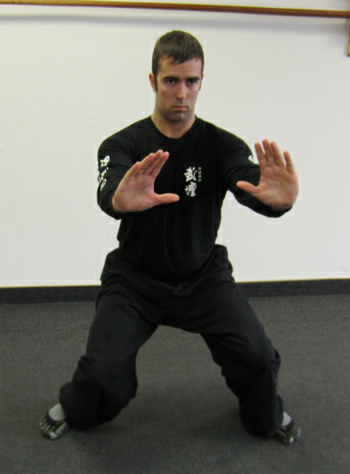
The most important of the eight stances is the horse-riding stance, which can be thought of as the mother of ba shi. The other stances, with their various weight distributions, angles and twists, are created from the horse-riding stance. In ancient times, this stance was sometimes used by sifus to test the sincerity and obedience of the student. Some students were first required to practice the stance for a long time before anything else would be taught to them. To eliminate distractions, they were sometimes made to practice facing a wall.
In this horse-riding stance (qi ma shi) the feet are parallel and point forward. The legs are positioned more than a shoulder width apart, the appropriate distance varying from student to student according to leg and body proportions. Each leg supports 50% of the body's weight. The back is naturally straight. The stance’s height should be lower than one’s comfort zone but not so low that the rear end is below knee level. In all of the ba shi, as in all aspects of kung fu, there is an exact method of execution that must be rigorously followed. The arms are relaxed, and extend forward with palms facing. The fingers reach nose level.
To emphasize qi ma shi, Sifu Hsu instructs his students to return to this stance between each of the other seven stances.
GONG JIAN SHI - THE BOW-AND-ARROW STANCE

The body pivots 90 degrees when moving from qi ma shi to gong jian shi (the bow-and-arrow stance). The leg which is to become the front leg pivots on the heel, as the rear leg pivots on the ball of the foot. If a line were drawn laterally between the legs, the toes of the front foot and heel of the rear foot would just touch it. 60% to 70% of the weight is on the front leg and the rest is on the rear. When this pivot is executed correctly the student has a good base. If the pivot is done wrong the stance may become too narrow. In a narrow version of this stance not only is it lacking balance and stability, but also if the student were to deliver a kick with his rear leg, his front leg would interfere.
Sifu Hsu explains that many instructors assume that their students' poor stability in this bow-and-arrow stance is due to an inadequately stretched body, a lack of flexibility, when actually, the true problem is that the correct transition from qi ma shi to gong jian shi has not been taught.
When moving from gong jian shi back to qi ma shi the student must use the same pivot points: otherwise, his qi ma shi will be too wide, his legs having moved further apart.
In gong jian shi, when the right leg is forward the left hand is extended forward at nose level and in line with the forward knee and toes. The right hand is two palm-widths above the head.
XI SHI - THE EMPTY-LEG STANCE
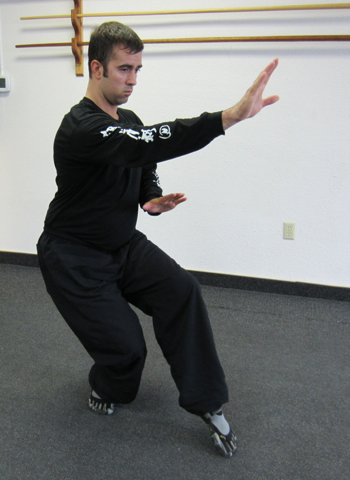
The Chinese say, “Every single-leg stance could be a leg attack.” With 100% of the weight on the rear leg, xi shi trains the student to maintain stability on one leg. If one’s entire weight can be comfortably supported by a single leg, there is no need to first shift one's weight before delivering a kick or knee attack. In making the transition from qi ma shi to xi shi, the student pivots 45 degrees at the waist. The front, or “empty leg,” rests lightly on the toe. This leg is slightly rotated in at the hip to cover the groin. All of the body's weight is supported by the rear leg. The upper hand (opposite hand of the empty leg) is at nose level. The lower hand reaches to below the upper arm's elbow. Both hands are in line with the nose, the forward knee, and the toe. In xi shi, as in each stance, the back is straight.
PU TUI SHI - THE LOW LEG-STRETCHING STANCE
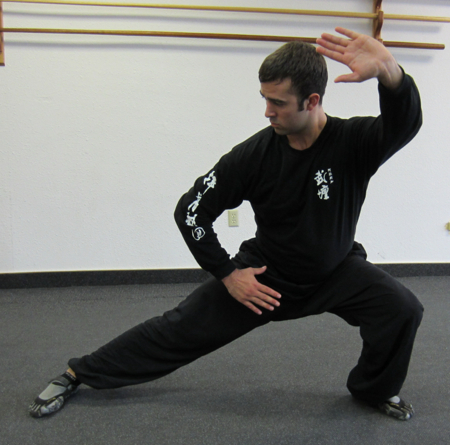
This is primarily a stretching stance. The student slowly sinks on to one crouched leg while the other leg slides the foot along the ground, until the leg is completely straight. Both feet must remain absolutely flat on the ground. If this cannot be accomplished without the student leaning forward, the teacher should know his student is not stretched enough. When returning to qi ma shi from pu tui shi, the leg must again move smoothly in one motion. If the student must pull his foot back in several jerking motions, the teacher knows the student’s legs are not strong enough. One hand is positioned above the head, the other is in front of the dan tian.
DU LI SHI - THE SINGLE-LEG STANCE
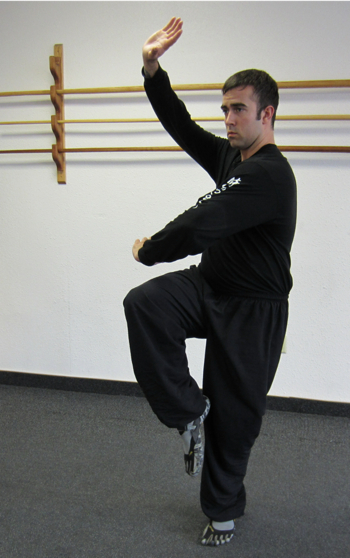
This single-leg stance promotes balance and stability. The student pivots 45 degrees at the waist. The supporting leg is bent slightly. A bent leg can act as the body’s shock absorber, whereas a straight leg, being too rigid, cannot. If one's leg is straight, he is likely to be jarred off balance by the impact of his own kick, should it connect with his opponent. The empty leg covers the groin. The foot covers the supporting leg’s knee. The upper hand is palm up, above the head. The lower hand covers the exposed ribs.
ZUO PAN SHI - THE SEATED-ON-OWN-TWISTED-LEG STANCE
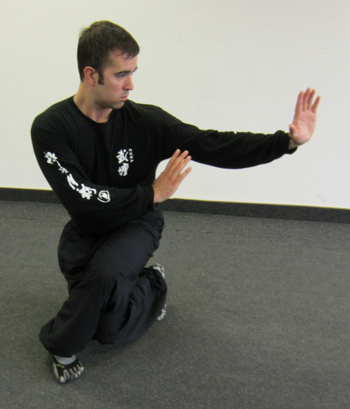
During combat it is sometimes necessary to change one's position or angle without weakening one's defense by moving the front leg. In this seated twisted-leg stance, the rear leg is used like a rudder to determine the angle. Zuo pan shi trains the student for the rudder-like action of the rear leg while the front leg remains stationary. To make the transition from qi ma shi to zuo pan shi, the rear leg steps behind the stationary leg, locking the knee against the outer calf for support, while the hands assume an “on guard” position. As in the other stances (except du li shi and pu tui shi), the body's height must remain constant during the transition. This stance should be secure enough to withstand a jarring attack.
SAN QI SHI - THE 30-70 STANCE
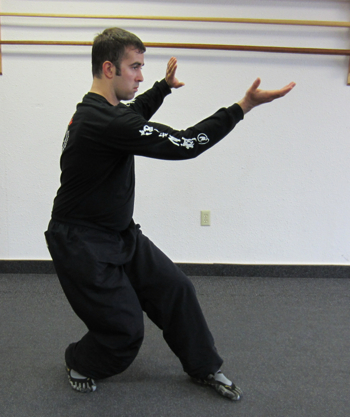
The student pivots 45 degrees at the waist. The rear leg supports 70% of the weight. The thigh and calf of the rear leg make a 130-degree angle. The front leg supports 30% of the weight. The forward arm is bent, the palm, at nose level, faces up. The back of the rear hand is behind the eye. In this stance the student should feel an extreme twist in the waist. The functions of san qi shi and shi liu shi have previously been explained.
SI LIU SHI - THE 40-60 STANCE
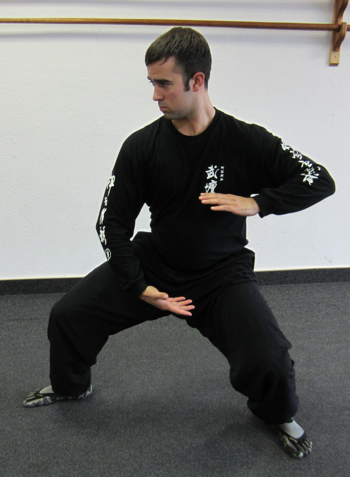
From qi ma shi, the leg that is to become the front leg pivots on the heel almost 90 degrees. The rear leg now has 60% of the weight, the front leg 40%. The rear leg’s knee should not cave inward but remain in alignment with the foot. The thigh and the calf of the rear leg make a 70-degree angle. The palms of the upper and lower hands face each other, one at waist level, the other at shoulder level.
LIFE-LONG KUNG FU TRAINING
Most sifus teach the ba shi as basic training only. Their instruction is usually limited to the first level, although a few do teach the second level, basic qi training. Sifu Hsu teaches the ba shi as a lifelong practice. In the beginning, the ba shi introduces the student to the precise stance-work that is integral to Northern Chinese kung fu. At the middle level, the process focuses on an awareness of the proper breathing technique and begins the long journey toward cultivating abundant qi. The third level of the ba shi has no ending. Here, the student learns to command the qi, to be the general of all his resources, from the muscles of his physical body to the most subtle forms of his inner energy. Through perseverance, intelligence and patience, the student may someday achieve the rare union of mind and body.
---[ "Ba Shi: The 8 Basic Stances" - Richard Miller - Inside Kung Fu, November, 1981.
Reproduced here with photo of Master Kurt Wong pounding-the-fist
and Dan Bolinder in 8 photos of stances. ]---
< Return to ARTICLES INDEX
TOP /\

